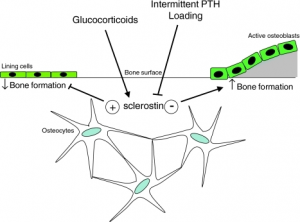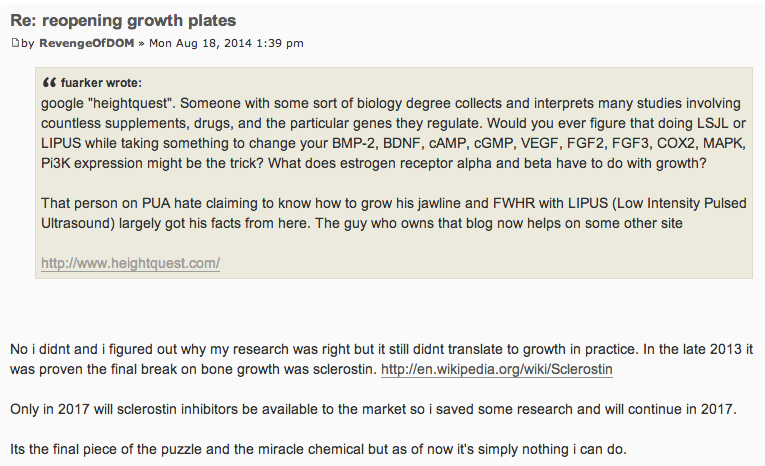Sclerostin Inhibitors Promotes Bone Growth and Protects Against Cartilage Degradation
 Due to the nature and subject which we do research on, we often find that our work/research is referenced by certain websites and forums which focuses on talking about very controversial and questionable subjects. The tracking software for the website revealed that the PUA Hate forum was at one time linking to the website, before it was taken off line from the amount of negative media attention it got after what one of its former members Rodger Elliot did.
Due to the nature and subject which we do research on, we often find that our work/research is referenced by certain websites and forums which focuses on talking about very controversial and questionable subjects. The tracking software for the website revealed that the PUA Hate forum was at one time linking to the website, before it was taken off line from the amount of negative media attention it got after what one of its former members Rodger Elliot did.
It took maybe 1 month before some other places similar to PUA Hate started to link to us, with almost the exact same type of social mentality. We are referring to the forum SlutHate.com. I guess for a certain percentage of the male population in any society, there is a lot of anger towards women. I don’t promote these philosophies and don’t agree with what they think. However, sometimes the members do link to something which reveals a very interesting find. That is what happened this time.
One thread on the sluthate forum talked about the possibility of “reopening the growth plates” and a poster going by the name RevengeOfDOM mentioned a chemical which I have not heard about before. Refer to the clipped picture of his post below…
 It seems that this guy has also been doing his own research on growing taller like us in parallel. It is just that he does not publically publish what he finds. His mention of the class of chemicals which can inhibit this compound known as Sclerostin shows that he understands the stuff very well.
It seems that this guy has also been doing his own research on growing taller like us in parallel. It is just that he does not publically publish what he finds. His mention of the class of chemicals which can inhibit this compound known as Sclerostin shows that he understands the stuff very well.
After looking at his other posts, he gave a rather good explanation on how to increase the width of one’s shoulder, talking about the costal cartilage in the sternum area, which we just did, so he knows what he is talking about. Technically, young guys can increase their shoulder width by making the costal cartilage in the ventral sternal area expand through weight lifting and taking HGH in as an adult.
I just did a quick search through Google and PubMed to see what is the potential of this compound class. Here is what I found…
- Increased chondrocyte sclerostin may protect against cartilage degradation in osteoarthritis
- Sclerostin is expressed in articular cartilage but loss or inhibition does not affect cartilage remodeling during aging or following mechanical injury.
- Role of sclerostin in bone and cartilage and its potential as a therapeutic target in bone diseases
I personally have not had the time to look over those studies above which I just linked to. However, there was one study which made me realize that this chemical compound has huge potential.
The reason why this study was the one that was most interesting was a recent find which showed that the reason why Osteoblasts can’t transdifferentiate into Chondrocytes is due to the conanical Beta-Catenin/Wnt Pathway. A quick guess would be that any chemical that can inhibit the conanical Beta-Catenin/Wnt pathway would mean that maybe Osteoblasts could possibly turn into chondrocytes, and thus regular bone tissue would turn into cartilage tissue.
(Note: Interestingly, Tyler talked about the possibility of inhibiting Sclerostin in a post which I did not read yet “New LSJL study(but bone effects only)”
Of course the entire process to reopen growth plates obviously wouldn’t be that easy and simple. This type of research is amazingly hard to get right, since there are probably thousands of young men in the world currently looking into trying to do what we are trying to do, scouring through the PubMed database for interesting studies.
In addition to these PubMed published papers, other sources show that it has bone growth potential. In an article entitled “Novel Osteoporosis Drug Could Change Treatment: Study – Early results indicate romosozumab can rebuild bone” by the Colonial Heights Surgery Center, the chemical compound which is called romosozumab was shown to be able to increase the BMD (Bone Mineral Density) in Lumbar vertebrate bone much more significantly than any of the commercial types of BMD stimulants that is commonly used. (Quote: “The new drug uses an antibody to block the function of sclerostin, a protein the body produces to naturally inhibit bone growth”) When the romosozumab was compared to other compounds like teriparatide (Forteo) and alendronate (Fosamax), which is supposed to be some type of biphosphonase. If I remember correctly, I think I wrote a piece on Fosamax about a year ago looking at its potential for bone growth but ultimately concluded that these types of chemicals would never increase the bone’s volume, but the bones’s BMD.
These new class of sclerostin inhibitors are much better than those other compounds at increasing the BMD. For a better understanding on the effects of decreasing the effects of Sclerostin, refer to the study “Targeted Deletion of the Sclerostin Gene in Mice Results in Increased Bone Formation and Bone Strength“ published back in 2008 and written by Xiaodong Li, Michael S Ominsky, et. al.
So how effective is this compound for height increase or bone growth?
When you are looking for a type of chemical compound group which has promise in promoting bone mineral density and reversing osteoporosis in old age, these sclerostin inhibitors seem to do an amazing job. The compound known as romosozumab is probably just one in that class maybe.
However, we can already seen that at least for one person, they did not see any practical results. As they said on the forum, “…it did not translate into practice“. It would sound like that this person got their hands on sclerostin somehow and injected it or orally took it and did not see any height gain.
However, they said that these inhibitors wouldn’t be available until 2017 to the general public. It seems that he is going to wait until 2017 when these “breakthrough” chemical compounds finally reach the general public and the general market before starting his research again.
Based on my personal opinion though, I don’t think this chemical would be able to do what we are hoping it would do.
Increasing bone growth through BMD is a useless way to do it. It may in fact make the job even worst. However, I would still need to look further at its anabolic effects on cartilage tissue, and what happens when it inhibits the Wnt pathway.
I am not saying that this compound has no potential. It actually has a lot of potential, if the research on its cartilage tissue regenerative abilities turn out to be really high.
That is why I conclude this post by saying that I will at some point go back to this class of chemicals to see just how well can it repair the damage from articular cartilage degeneration.
